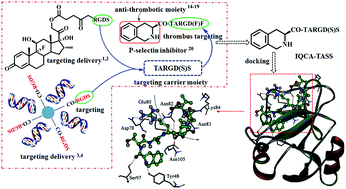IQCA-TASS: a nano-scaled P-selectin inhibitor capable of targeting thrombus and releasing IQCA/TARGD(S)S in vivo†
Abstract
Thrombosis is a serious threat to human health worldwide. Tetrahydroisoquinoline-3-carboxylic acid (IQCA) is an antithrombotic agent, while Thr-Ala-Arg-Gly-Asp(Ser)-Ser (TASS) can target thrombus. Herein, tetrahydro-isoquinoline-3-carbonyl-Thr-Ala-Arg-Gly-Asp(Ser)-Ser (IQCA-TASS) was designed with the aim towards the discovery of a nano-delivery system for targeting thrombus. In vitro, IQCA-TASS acted on P-selectin and down-regulated P-selectin expression. The IC50 values of IQCA-TASS against the platelet aggregation induced by four aggregators were less than 0.45 nM. In vivo, IQCA-TASS targeted thrombus, released IQCA and TASS inside the thrombus, showed dose-dependent anti-thrombotic action, of which the minimal effective dose was 1 nmol kg−1, and showed anti-inflammatory action. Even with the dose up to 1 μmol kg−1, a dose of 1000 times the minimal effective dose, IQCA-TASS still induced no toxic reaction. In rat plasma, IQCA-TASS formed nanoparticles with diameters of less than 41 nm. The interactions of the nanoparticles with both resting and activated platelets were imaged. IQCA-TASS should be a safe nano-medicine capable of targeting thrombus and releasing anti-thrombotic/anti-inflammatory pharmacophores in disease sites.



 Please wait while we load your content...
Please wait while we load your content...